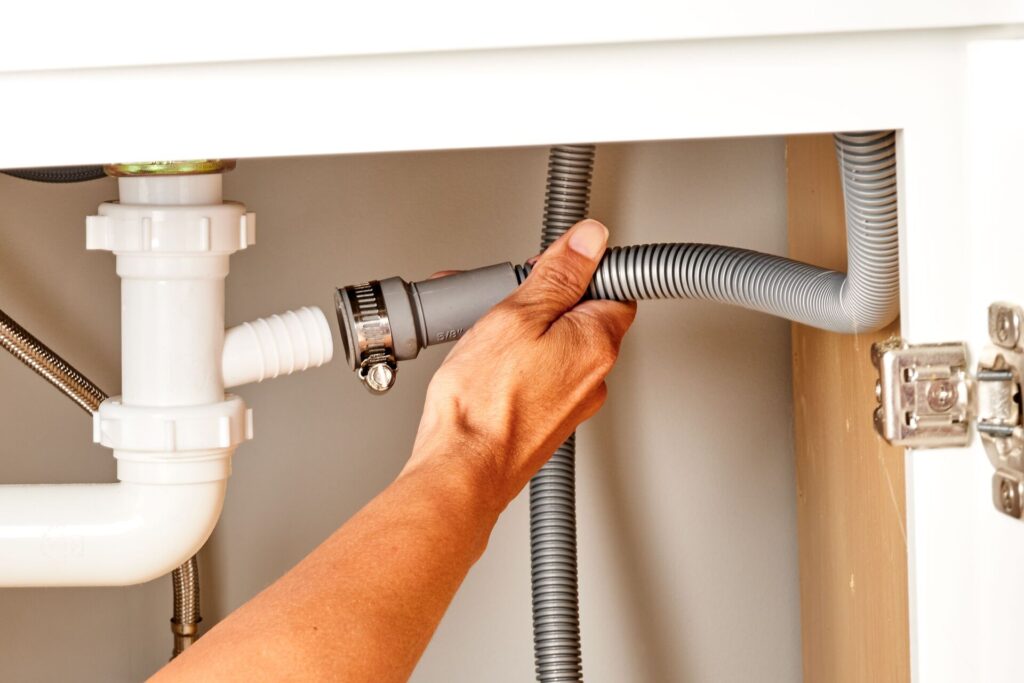Introduction:

We’ve all been there. You finish a hearty meal, load up the dishwasher, and then notice the dreaded sight: your sink filled with water, seemingly backing up from the dishwasher. This plumbing problem isn’t just an inconvenience; it’s a potential health hazard. In this guide, we’ll delve deep into the reasons behind this dishwasher obstruction and offer practical solutions. So, whether you’re a Cypress/NW Houston resident or from elsewhere, let’s get that kitchen plumbing back in tip-top shape!
A brief overview of the inconvenience and potential health hazards of sink water backing up into the dishwasher:

When your dishwasher backs up into the sink, it’s more than just a minor annoyance. Standing water can become a breeding ground for bacteria, leading to unpleasant odors and potential health risks. Moreover, water overflow can damage your kitchen cabinets and flooring. There’s also an electric shock risk if water comes into contact with electric appliances. Hence, addressing this issue promptly is not just about convenience but safety too.
Emphasis on the importance of addressing the issue promptly:
Ignoring a dishwasher backflow or a kitchen sink blockage can lead to more severe drainage problems in the long run. Water damage prevention is crucial for both the safety and longevity of your home. Moreover, the longer you wait, the more challenging and potentially expensive the solution can become. Whether it’s a simple clog removal or a more complex drainage correction, it’s always best to act swiftly.
1. Understanding the Common Culprits:
Hey there! If you’ve ever been greeted by a sink filled with water after running your dishwasher, you’re not alone. This common plumbing problem can be a real headache, but with a bit of knowledge, you can tackle it head-on. Let’s dive into the intricacies of how your sink and dishwasher are connected and why this might be happening.Explanation of how the sink and dishwasher share the same water source, leading to potential backups:
Your sink and dishwasher are like siblings in the world of kitchen plumbing. They share the same water source, and when one gets into trouble (like a mischievous younger brother), the other often feels the effects. When your dishwasher runs, it drains the water through a hose connected to the sink’s drainage system. If there’s a blockage or obstruction in this shared system, water can back up, causing that dreaded overflow into the sink.
2. Clogs in the Sink Drain:
Now, let’s talk about one of the most common culprits: clogs in the sink drain. From food particles to grease and detergent buildup, various factors can lead to a blocked drain. But fear not! With the right tools and techniques, you can clear that clog and get your kitchen back to its best.
Importance of unplugging the garbage disposal for safety:
Before we dive into the nitty-gritty, a word of caution. If you have a garbage disposal, always, always unplug it before attempting any fixes. It’s not just about preventing an electric shock risk; it’s about ensuring you don’t accidentally turn it on while working. Safety first, always!
Dangers of using liquid drain cleaners and the benefits of professional solutions like drain snakes:
Liquid drain cleaners might seem like a quick fix, but they come with their own set of problems. Not only can they be harmful to the environment, but they can also damage your pipes over time. Instead, consider more professional and effective solutions. Ever heard of a drain snake? It’s a plumber’s best friend when it comes to clog removal. A drain snake, also known as a cable auger, is a long, flexible tool that can be manually cranked to reach deep into your drain and dislodge blockages. It’s a safer and more effective alternative to chemical cleaners.
3. Dishwasher Drain Hose Issues:


Hey there, DIY enthusiast! Let’s chat about another common culprit behind that sink filled with water after running your dishwasher: the garbage disposal. This handy kitchen appliance is a blessing when it’s working correctly, but when it’s not, it can lead to some pesky plumbing problems.
How a clogged or jammed garbage disposal can lead to backups:
Your garbage disposal and dishwasher are closely connected in the world of kitchen plumbing. When the garbage disposal gets clogged or jammed, it can prevent water from draining correctly. This can cause the water to back up into the sink or even into the dishwasher. Think of it like a traffic jam; if one road (or drain) is blocked, it can cause a backup in another.
The importance of removing the drain plug, especially after a new installation:
If you’ve recently installed a new garbage disposal or had a dishwasher installation, there’s a tiny but crucial step you might’ve missed: removing the drain plug cover. This plug prevents water from the dishwasher from draining into the disposal. If it’s not removed, you’ll find your sink filled with water in no time. So, if you’ve recently made any changes, double-check this little detail.
Maintenance tips for garbage disposals, including eggshell grinding and vinegar treatments:

To keep your garbage disposal in tip-top shape, consider these maintenance tips:
- Eggshell Grinding: Contrary to popular belief, grinding eggshells isn’t bad for your disposal. In fact, it can help sharpen the blades and clear out any potential obstructions.
- White Vinegar Treatment: Every once in a while, pour a cup of white vinegar down the disposal and let it sit for an hour. Then, rinse with cold water. This helps in breaking down grease and other buildups.
- Regular Cleaning: Use a bottle brush to clean the inside of the disposal regularly. This can help prevent food waste buildup and potential clogs.
6. Air Gap Blockages:
Moving on, let’s discuss the unsung hero of your dishwasher’s drainage system: the air gap. This little device might not seem like much, but it plays a pivotal role in preventing backflows and ensuring your dishwasher drains correctly.
The function of the air gap in backflow prevention:
The air gap acts as a barrier between your dishwasher and sink, ensuring that dirty sink water doesn’t flow back into your dishwasher. It’s a simple yet effective mechanism that’s crucial for the proper functioning of your kitchen plumbing system.
Signs of a clogged air gap and steps for cleaning and maintenance:
If you notice water overflowing from the air gap or if your sink is clogging frequently, it might be a sign that the air gap is clogged. Here’s how you can maintain it:
Regular Inspection: Periodically check the air gap for any visible debris or blockages. Cleaning: Remove the cover and use a bottle brush to clean the inside. This can help in debris removal and prevent potential blockages. Professional Help: If you’re unsure about the issue or can’t seem to fix it, consider seeking advice on Air Gap Clog Solutions to ensure it’s always functioning correctly.
7. Proactive Prevention and Maintenance:
Hey there, future plumbing pro! Now that we’ve delved deep into the intricacies of dishwashers and sinks, let’s talk about something even more crucial: prevention. As the old saying goes, “An ounce of prevention is worth a pound of cure.” By taking a few proactive steps, you can avoid many common plumbing problems and keep your kitchen running smoothly.
Regularly cleaning the dishwasher drain and strainer:

Your dishwasher works hard for you, cleaning and sanitizing your dishes day in and day out. But just like any hard worker, it needs a little TLC from time to time. Regularly cleaning the dishwasher drain and strainer can prevent debris buildup and ensure smooth water drainage. Here’s how:
Remove the Bottom Rack: This will give you clear access to the dishwasher drain.
- Inspect for Debris: Look for any food particles or other obstructions.
- Clean the Strainer: Using a soft brush, gently scrub the strainer to remove any buildup.
- Rinse and Replace: Once cleaned, rinse the strainer with warm water and place it back in its position.
Avoiding excessive dishwashing detergent:
More doesn’t always mean better, especially when it comes to dishwashing detergent. Using too much can lead to detergent buildup, which can obstruct the dishwasher and even lead to water backup. Always follow the manufacturer’s recommendations and adjust based on the hardness of your water.
Scrape off food residues before washing dishes:
While it might be tempting to toss dishes with food residues directly into the dishwasher, taking a moment to scrape off leftovers can make a world of difference. This simple step can prevent food waste clogs and keep your dishwasher running efficiently.
Proper disposal of cooking grease:
We’ve all been there – standing with a pan full of cooking grease, wondering where to pour it. The answer? Never down the drain! Grease can solidify and cause blockages in your plumbing system. Instead, pour it into a container, let it solidify, and then dispose of it in the trash.
Conclusion:
In the grand symphony of kitchen plumbing, every component plays a vital role. From the humble air gap to the powerful garbage disposal, each part works in harmony to ensure a smooth performance. But like any orchestra, it requires regular maintenance and a keen ear (or eye) for potential issues. By following the tips and advice shared in this guide, you can prevent common plumbing problems and ensure your kitchen remains the heart of your home.
FAQ:
Ah, the frequently asked questions! Every plumber’s favorite section. Let’s dive into some of the most common queries folks like you have about dishwashers and sinks. And remember, there’s no such thing as a silly question when it comes to plumbing!
Q1: Why is there water at the bottom of my dishwasher after a cycle?
Ah, the age-old plumbing problem! If you find your dishwasher filled with water at the end of a cycle, it’s often due to a clog or blockage in the drainage line. Over time, food particles, detergent buildup, and other debris can obstruct the dishwasher drain, preventing water from draining out. Regular dishwasher maintenance, like cleaning the strainer and checking the drain hose, can help prevent this issue.
Q2: How often should I clean my dishwasher’s drain and strainer?
For optimal performance and to prevent any kitchen plumbing issues, it’s a good idea to clean your dishwasher’s drain and strainer every month. This not only prevents clogs but also ensures your dishes come out sparkling clean. Remember, a little proactive care goes a long way in preventing bigger plumbing problems down the line.
Q3: Can I use commercial drain cleaners to clear clogs in my sink or dishwasher?
Tread with caution here. While commercial drain cleaners might seem like a quick fix, they often contain harsh chemicals that can damage your pipes and harm the environment. Instead, consider using natural solutions like white vinegar or baking soda. For stubborn clogs, a sink snake or Drain Snake Application can be more effective and safer for your plumbing system.
Q4: What’s the role of an air gap, and do all sinks have them?
The air gap is a nifty little device that prevents dirty sink water from flowing back into your dishwasher. Not all sinks have them, but they’re crucial for preventing backflow and ensuring that your dishes are cleaned with fresh water. If you’re unsure whether your sink has an air gap or if it’s functioning correctly, it’s best to consult with a local plumber.
Q5: How can I tell if my garbage disposal is the cause of the backup?
If your sink is clogging frequently, especially after using the garbage disposal, it might be the culprit. Check for any jammed items, ensure the drain plug cover is removed (especially after a new installation), and regularly maintain it by grinding eggshells or using white vinegar treatments. If the problem persists, it might be time to call in a professional plumber.

